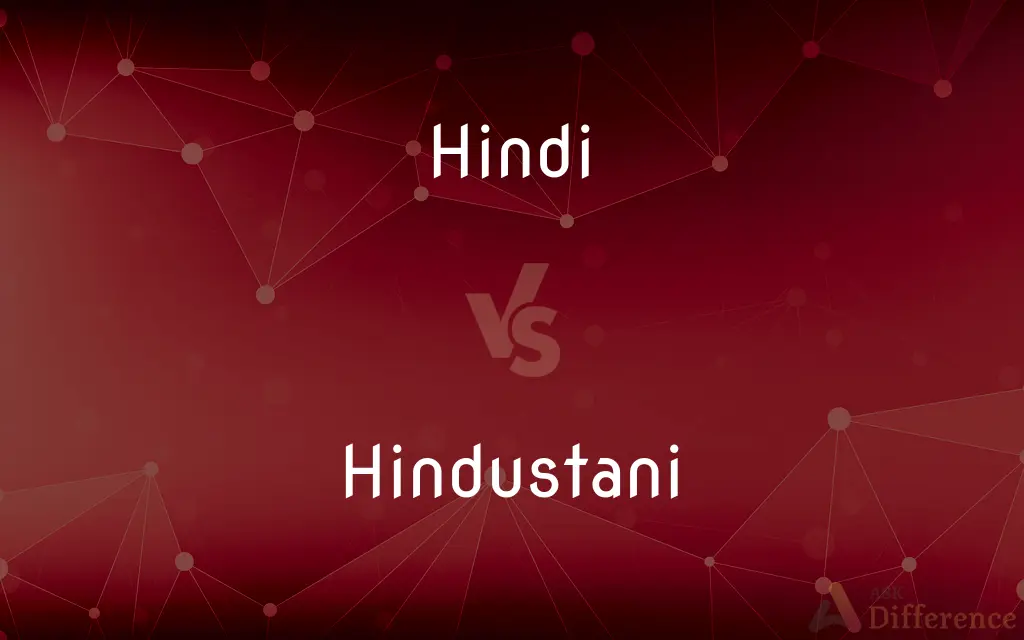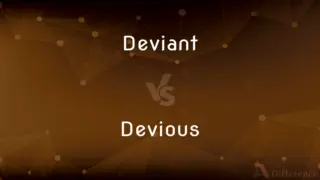Hindi vs. Hindustani — What's the Difference?
By Fiza Rafique & Maham Liaqat — Updated on April 16, 2024
Hindi is a standardized, Sanskritized language mainly spoken in northern India and an official language, while Hindustani combines Hindi and Urdu, blending Sanskrit and Persian-Arabic elements, serving as a lingua franca in the Indian subcontinent.

Difference Between Hindi and Hindustani
Table of Contents
ADVERTISEMENT
Key Differences
Hindi is officially written in the Devanagari script and includes substantial vocabulary from Sanskrit, making it one of the two official languages of India, used in government, media, and educational settings, whereas Hindustani is a more colloquial form encompassing both Hindi and Urdu, fluid in its use of the Persian-Arabic and Sanskrit vocabularies.
Hindustani, as a term, historically refers to the spoken language that predates and contributes to the formation of both contemporary Hindi and Urdu; it includes elements accessible to speakers of both languages, while Hindi tends to adhere more strictly to Sanskritic linguistic norms.
In everyday usage, particularly in informal and interpersonal communication across different linguistic communities in India, Hindustani serves as a practical communication bridge, demonstrating greater flexibility and inclusivity in vocabulary and expression, in contrast, Hindi often assumes a more formal tone and structure.
Hindi has evolved with a clear institutional backing from language academies and is used in official documents and serious literature, on the other hand, Hindustani remains a vibrant part of popular culture, especially in Bollywood cinema and music, where its accessibility and mixed linguistic heritage are seen as advantages.
While Hindi primarily targets native speakers and learners in formal educational environments, Hindustani’s utility is recognized in its widespread informal use across various regions, transcending strict linguistic boundaries, whereas Hindi's formal application makes it crucial for official and academic purposes.
ADVERTISEMENT
Comparison Chart
Script
Devanagari
Uses both Devanagari (for Hindi) and Perso-Arabic (for Urdu).
Vocabulary
Sanskrit-based, formal.
Mix of Sanskrit and Persian-Arabic, flexible.
Usage Context
Formal settings, education, official documents.
Informal speech, popular media, inter-group communication.
Geographic Reach
Primarily northern India, as an official language.
Widespread use as a lingua franca across South Asia.
Cultural Association
Associated with Indian nationalism and formal education.
Associated with popular culture, including Bollywood and music.
Compare with Definitions
Hindi
A standardized language of northern India, using Devanagari script.
Hindi is taught across schools in India.
Hindustani
A colloquial blend of Hindi and Urdu, easily understood across many regions.
Hindustani is often spoken in the markets of Delhi.
Hindi
Promotes Sanskritized vocabulary for linguistic purity.
Hindi news broadcasts use Sanskrit-derived terms for new technologies.
Hindustani
Less formal, widely used in daily communication.
Casual conversations in North India often default to Hindustani.
Hindi
Integral to Indian cultural and national identity.
Hindi Diwas celebrates the adoption of Hindi as an official language.
Hindustani
Utilizes a flexible mix of vocabulary from Persian, Arabic, and Sanskrit.
Hindustani in Bollywood films often includes both Urdu and Hindi terms.
Hindi
Official language used in government and administrative communication.
Official documents in India are often drafted in Hindi.
Hindustani
Acts as a lingua franca in diverse linguistic landscapes.
Hindustani facilitates communication between Hindi and Urdu speakers.
Hindi
Rich in formal and academic literature.
Classical Hindi literature includes works by Premchand.
Hindustani
Prominent in popular culture, especially in music and cinema.
Classic Bollywood songs are typically sung in Hindustani.
Hindi
Hindi (Devanagari: हिन्दी, IAST/ISO 15919: Hindī), or more precisely Modern Standard Hindi (Devanagari: मानक हिन्दी, IAST/ISO 15919: Mānak Hindī), is an Indo-Aryan language spoken chiefly in India. Hindi has been described as a standardised and Sanskritised register of the Hindustani language, which itself is based primarily on the Khariboli dialect of Delhi and neighbouring areas of Northern India.
Hindustani
A group of Indic dialects including the spoken form of Hindi-Urdu that function as a lingua franca throughout much of northern and central India.
Hindi
An Indic language of northern India, derived from Sanskrit and written in the Devanagari script. It is the fourth most widely spoken language in the world, with more than 250 million people speaking it as their first language.
Hindustani
Of or relating to Hindustan, its people, or the Hindustani language.
Hindi
Relating to Hindi.
Hindustani
Of or pertaining to Hindustan or its inhabitants.
Hindi
A group of vernacular Indic dialects spoken in northern India.
Hindustani
A native or inhabitant of Hindustan or India.
Hindi
The literary and official language of northern India that is based on these dialects. It is written in Devanagari and uses Sanskrit as a resource language.
Hindustani
A form of Hindi spoken around Delhi. See Hindoostanee.
Hindi
The name given by Europeans to that form of the Hindustani language which is chiefly spoken by native Hindus. In employs the Devanagari character, in which Sanskrit is written.
Hindustani
A native or inhabitant of Hindustan or India
Hindi
The most widely spoken of modern Indic vernaculars; spoken mostly in the north of India; along with English it is the official language of India; usually written in Devanagari script
Hindustani
A form of Hindi spoken around Delhi
Hindi
Of or relating to or supporting Hinduism;
The Hindu faith
Hindustani
Of or relating to or characteristic of Hindustan or its people or language
Common Curiosities
Why is Hindustani important in popular culture?
Hindustani's flexibility and inclusive vocabulary make it particularly suitable for music, cinema, and other forms of popular entertainment, resonating with a wide audience.
How are Hindi and Hindustani taught?
Hindi is formally taught in educational systems using a standardized curriculum, whereas Hindustani is often learned informally through cultural exposure and interpersonal communication.
What is the main difference between Hindi and Hindustani?
Hindi is a more formal, standardized language with heavy Sanskrit influence, while Hindustani is a colloquial blend of Hindi and Urdu used widely across South Asia.
Can Hindi speakers understand Hindustani?
Yes, Hindi speakers can generally understand Hindustani due to its significant overlap with Hindi, especially in everyday vocabulary.
How does the script usage differ between Hindi and Hindustani?
Hindi exclusively uses the Devanagari script, while Hindustani encompasses usage of both Devanagari and Perso-Arabic scripts, depending on the context and audience.
What is the future of Hindustani in the digital age?
The digital age, with its diverse media platforms, likely enhances the use of Hindustani, as it adapts easily to informal communication and digital content creation.
Is Hindustani recognized as an official language?
Hindustani itself is not recognized as an official language; however, its derivatives, Hindi and Urdu, are official languages in India and Pakistan, respectively.
Is there a political dimension to the use of Hindi vs. Hindustani?
Yes, the promotion of Hindi often aligns with nationalist agendas, emphasizing cultural unity under a single linguistic standard, whereas Hindustani represents a more inclusive, culturally pluralistic approach.
How do non-native speakers perceive Hindi and Hindustani?
Non-native speakers may find Hindustani easier to grasp due to its prevalence in popular media, while Hindi might be approached more through academic or formal learning contexts.
What role does Hindustani play in India's linguistic landscape?
Hindustani serves as a lingua franca, bridging linguistic gaps between different language speakers across northern and central India.
What impact has Bollywood had on Hindustani?
Bollywood has played a significant role in popularizing Hindustani, using it extensively in dialogues and songs to ensure broader reach and emotional impact.
What are the implications of using Hindustani in education?
While not formally recognized in educational syllabi, using Hindustani in educational settings can facilitate more inclusive and accessible communication.
Why might someone choose to speak Hindustani over Hindi?
Choosing Hindustani may be practical for informal settings and in areas with diverse linguistic groups to ensure better mutual understanding and inclusivity.
Can knowledge of Hindustani enhance understanding of South Asian cultures?
Yes, since Hindustani draws from multiple linguistic traditions, it provides insights into the cultural and historical confluences that shape South Asia.
What are the professional benefits of learning Hindi over Hindustani?
Learning Hindi can offer professional advantages in formal sectors such as government, education, and in regions where it is the lingua franca or required for official use.
Share Your Discovery

Previous Comparison
Resolution vs. Denouement
Next Comparison
Deviant vs. DeviousAuthor Spotlight
Written by
Fiza RafiqueFiza Rafique is a skilled content writer at AskDifference.com, where she meticulously refines and enhances written pieces. Drawing from her vast editorial expertise, Fiza ensures clarity, accuracy, and precision in every article. Passionate about language, she continually seeks to elevate the quality of content for readers worldwide.
Co-written by
Maham Liaqat













































